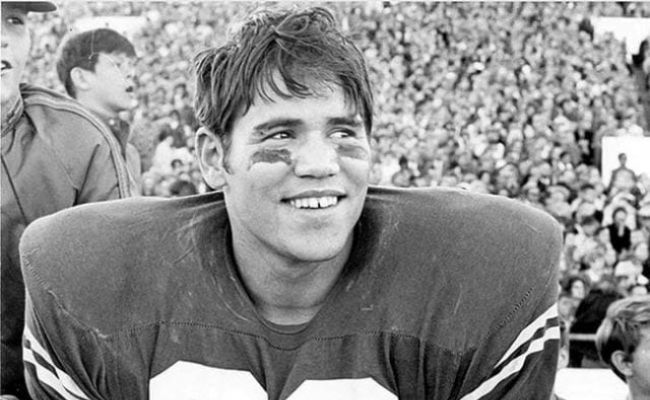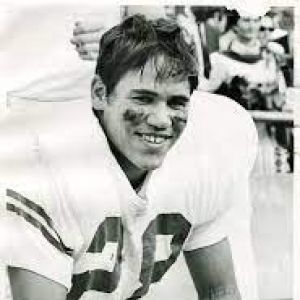Check our most recent updates about Freddie Steinmark’s Estimated Net Worth, Age, Biography, Career, Height, Weight, Family, Wiki. Also learn detailed information about Current Net worth as well as Freddie Steinmark’s earnings, Worth, Salary, Property, and Income.
Freddie Steinmark was an undersized University of Texas defensive back with a fierce desire to win, whose valiant battle against osteosarcoma (bone cancer) made him a national symbol of courage and determination.
In addition, he was the starting safety for the UT Longhorns’ 1969 National Championship football team. He may not be the best athlete, but his bravery and determination have set him apart from the crowd.
What is the net worth of Freddie Steinmark?
Freddie Steinmark’s net worth is about $3 million.

Freddie Steinmark: Birth & Professional Career
Frederick Joe Steinmark was born on January 27, 1949, in Denver, Colorado. Freddie was introduced to sports at a young age, particularly football, which he grew to love and play enthusiastically.
Throughout his sports career, Freddie Steinmark rarely lost a game, and he led his high school team to remarkable victories that lifted the spirits of people in his small town in Colorado.
As a result, he received numerous accolades and mentions. He not only stayed on top of his game, but he also made a name for himself academically. In his senior year, he received the Denver Post’s Golden Helmet Award as well as the Colorado Hall of Fame award for being an outstanding scholar and athlete.
Furthermore, he was ranked 25th out of 530 students in his high school graduating class. Despite his outstanding performances, skill, and knowledge of the game, his small stature made it nearly impossible for him to be noticed by Division 1 schools.
Notre Dame, his dream school, did not consider him for the same reason – his size – but he never let that deter him from his big dream, which was to play his beloved sport in college and on a professional level.
Eventually, his seemingly limitless potential and scholastic ability triumphed over his apparent physical limitation. He had offers from both the Texas Longhorns and the Cincinnati Reds but chose the former.
Freddie was recruited by Texas coach Darrell Royal, who was also an undersized player for the Oklahoma Sooners. In 1967, he recognized Steinmark’s talent and offered him a scholarship to UT. Bobby Mitchell, Freddie’s 200-pound teammate, was also recruited.
He went on to become an important member of the Texas Longhorns. During the offseason, he never stops playing sports, but he would play baseball – the smoothness of which he said was a nice contrast to the roughness of football – to stay in shape.
On December 6, 1969, Steinmark was a member of the Texas Longhorns in their 15–14 victory over the Arkansas Razorbacks in what sportswriters dubbed “The Game of the Century.” He limped through the game due to severe thigh pain, which was revealed by an X-ray two days later to be a malignant bone tumor just above his left knee.
Four days later, his left leg was amputated at the hip at the M.D. Anderson Cancer Center in Houston. Freddie, saddled with a resilient spirit, stood valiantly on the Cotton Bowl sidelines, balancing on one leg with crutches only 20 days after the operation, cheering as his team defeated Notre Dame.
On June 6, 1971, the feisty competitor whose fearless play and valiant fight against osteosarcoma made him a symbol of courage and hope died after a nationally publicized battle with bone cancer.
Freddie Steinmark: Parents and Siblings
His mother, Gloria Marchitti, is an Italian American, and his father, Fred Gene Steinmark, is an American (Big Fred, 1929-2000).
Fred was a really good player in his own right and played minor league baseball, but his major league career was cut short by injuries from a head-on car-truck collision and fatherhood.
Freddie was preceded in death by three siblings: a brother, Sammy, and two sisters, Paula Kay “P.K.” Stevenson and Gloria Gene “GiGi” Kunz.
During his early years, his father encouraged him to participate in all sports and coached him.
While Freddie inherited his father’s incredible work ethic and most of his athletic ability, he learned faith and family devotion from his mother. The Steinmarks are devout Roman Catholics.
Freddie Steinmark: Wife
Freddie Steinmark dated and almost married his girlfriend Linda Wheeler during his lifetime. They first met in eighth grade and remained together until Freddie lost his leg.
He thought he was going to die and suggested they end their relationship. They did for a while, but later reconciled and got engaged. Steinmark, sadly, died before they could marry.
Linda worked as a consultant on the biopic film My All American, and she presumably married. Mackenzie Meehan, her daughter, is an actress who played a nurse in the film.
Freddie Steinmark: Death
Freddie Steinmark’s determination to overcome any obstacle was evident throughout his life. He never let the stress of a problem get to him, and he worked hard to keep his morals intact, not allowing obstacles to deter him.
He lived his last 17 months in the spotlight with humor, grit, and grace, from the moment he was diagnosed. He continued his studies, responded to numerous letters and speaking invitations, coached freshmen, served as an American Cancer Society spokesman, and underwent chemotherapy.
His last hospitalization was on April 20, 1971, for issues related to the original problem that had plagued him. Despite the fact that he continued to receive extensive therapy, the disease progressed.
After a year and five months of valiant battle, the valiant soldier could no longer keep up with the pains and took his last bow on June 6, 1971.
He was laid to rest a few days later in Denver’s Mount Olivet Cemetery. However, his death implies that he accomplished more than he did during his lifetime.
His fight against cancer prompted the United States Congress to pass the National Cancer Act of 1971, which President Richard Nixon signed into law, kicking off the “War on Cancer.”
He also had a huge impact on everyone around him and became an inspiration to countless young people all over the country, including the Longhorns.
A large picture of him still hangs on the wall outside their locker room, and all of the football players touch it as they walk onto the field for good luck.
Freddie Steinmark: Autobiography and Legacy
Freddie enlisted the help of legendary sportswriter Blackie Sherrod to write his autobiography, I Play to Win, which was published posthumously three months after his death. It chronicles his years as a starting defensive football safety as well as a personal account of his faith in God, which became his most powerful ally in the face of adversity.
Other books, documentaries, and films based on his life have been produced, including the 2015 film, My All American, based on Jim Dent’s book, Courage Beyond the Game: The Freddie Steinmark Story, Freddie Steinmark: Faith, Family, Heart (2015) written by his close friend and teammate, Bower Yousse and Thomas J. Cryan.
On September 23, 1972, the scoreboard at Darrell K Royal-Texas Memorial Stadium was dedicated to Freddie Steinmark, and after the stadium was remodeled, the current version nicknamed Godzillatron, which stands 47 feet tall, was rededicated to him in 2015.
Furthermore, the Denver Rocky Mountain News annually bestows the Fred Steinmark High School Athlete of the Year Award on Colorado high school students who excel in athletics, academics, and citizenship.
Also Read: Elizabeth Hurley, Peter McKinno
Freddie Steinmark: Height and Weight
Aside from the sarcoma, one factor that nearly derailed his career was his perceived small size.
However, he demonstrated that where size fails, determination and courage always triumph.
He stood 5 feet 9 inches (1.75 meters) tall and weighed 165 pounds (75 kg).




